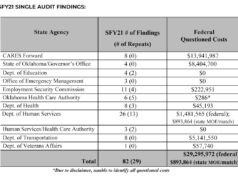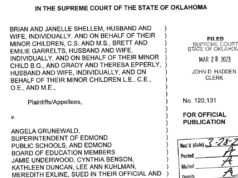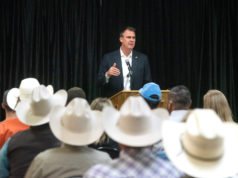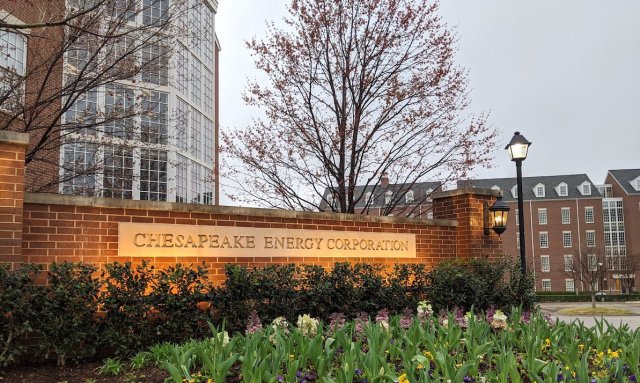
In 2007, Forbes named Oklahoma City-based Chesapeake Energy the “best managed” oil and gas company in the country. It was a designation based not only on the firm’s financial success but also on the “management ability, innovation and leadership” of its executives, including co-founder and CEO Aubrey McClendon.
At the time, Chesapeake was (literally) breaking new ground as a leader of the fracking and natural gas boom, and it was making a lot of money along the way. When the company won that Forbes title, its stock was trading at about $28 and climbing steadily toward what would be its peak of nearly $70 a year and a half later.
In oil-and-gas years, 2008 was a long time ago. Chesapeake’s stock hasn’t been above $1 since November 2019. In recent months — with energy prices tanking owing to the combined effects of the COVID-19 outbreak and a price war between Russia and Saudi Arabia — the price has rarely gone higher than $0.20.
Monday, the company moved forward with a reverse stock split at a one-for-200 ratio, which means every 200 shares on the market will be combined to create one share, effective April 15. The move is aimed primarily at raising the company’s stock price in order to avoid getting delisted from the New York Stock Exchange.
“In December, Chesapeake was notified we were no longer in compliance with the NYSE continued-listing standard due to the average price for our common stock over 30-consecutive trading-day period falling below $1 per share,” said James Webb, a Chesapeake executive vice president during the April 13 conference-call shareholder meeting.
A reverse stock split is a fairly drastic move, and it often signals a company grasping for survival.
Chesapeake — whose representatives declined requests to be interviewed for this story — has always been a roller coaster of a company. Its successes have been outsized and showy. Its struggles have been equally dramatic. It has been at the brink of failure more than once, only to bulldoze its way back.
Chesapeake has also been an integral part of Oklahoma life for the past few decades, employing thousands and playing a central role in Oklahoma City’s economic and cultural upswing in the early 2000s. It also helped to transform the wider U.S. oil and gas industry by ushering in the fracking era.
Now Chesapeake is grappling with an overwhelming debt load and a collapsed petroleum market. As it navigates what could be its final chapter, the company is a humbled version of its former self, reckoning with the far-reaching and complicated legacy of its glory days.
Boom and bust
Chesapeake was founded in 1989 by McClendon and Tom Ward. The two were in their 20s and working as landmen, responsible for identifying and leasing promising areas for oil and gas drilling.
McClendon, who studied history at Duke University with a minor in accounting, had plenty of connections in oil and gas. (His great-uncle was former Oklahoma Gov. and U.S. Sen. Robert S. Kerr, who co-founded the energy giant Kerr-McGee.) But McClendon’s early years of land-scouting were spent on the outskirts of the industry.
“Landmen were always the stepchild of the industry,” McClendon told Rolling Stone in 2012. “Geologists and engineers were the important guys — but it dawned on me pretty early that all their fancy ideas aren’t worth very much if we don’t have a lease. If you’ve got the lease and I don’t, you win.”
This focus on identifying and procuring land became central to Chesapeake’s rise and its general philosophy. After a near brush with bankruptcy in the 1990s, things took off in the early 2000s when the company became a leader in using a then-unusual technology that combined horizontal drilling and hydraulic fracturing.
This technique was less reliant on geological precision than traditional drilling and instead rewarded the ability to procure land access and drill as much as possible. Chesapeake became known for eating up real estate far and wide, and it became one of the more aggressive drillers in the industry.
Historically, people looking to make money in oil and gas have focused on the oil. But in the early 2000s, gas prices were high and, beyond that, McClendon held a firm belief that natural gas was the fuel of the future. At its peak, Chesapeake was the second-largest natural-gas producer in the world after ExxonMobil.
All of this leasing and drilling was expensive and required access to huge amounts of capital. Luckily, McClendon was great at procuring capital. (Ward left the company in 2006 to start Sandridge Energy, which he departed in 2013. Sandridge went through bankruptcy in 2016, announced February 2020 layoffs and has a stock price hovering around $1.)
‘Kind of a gold-rush mentality’
McClendon “was kind of a Saint Patrick,” according to Art Berman, a geologist and energy-industry analyst who has a reputation as a sceptic of the shale-drilling production model. “He could charm snakes and convince them to perish in the ocean. (…) He could convince anybody to give him money.”
Enabled by high gas prices, Chesapeake expanded dramatically and took on huge amounts of debt under McClendon.
McClendon was a vocal evangelist for both gas and the land areas in which he had invested. His enthusiasm and appetite for risk helped create what Berman called “kind of a gold-rush mentality,” and Chesapeake helped lead a boom in shale drilling and natural-gas production that started in the early 2000s.
Companies started drilling at a breakneck pace, but eventually the industry overtook itself. Natural gas became lavishly plentiful. These days, there’s so much natural gas being produced just as a side product of oil drilling that it often makes more financial sense to burn it off than to invest in harnessing it.
“You could say that they got too good at what they were doing,” said Roy Williams, CEO of the Oklahoma City Chamber of Commerce. “They pumped so much gas, and gas prices got so low that they couldn’t make money.”
Amid lackluster gas prices, Chesapeake’s debt started to catch up with it, and investors rankled at McClendon’s leadership. In 2011, just a few years after Forbes gave Chesapeake that “best managed” title, the magazine put McClendon on its cover with the headline “America’s Most Reckless Billionaire.” A year later, activist investor Carl Icahn revealed that he had purchased a 7.6 percent controlling stake in the company, foreshadowing McClendon’s exit.
At the same time, the company was being hit by various lawsuits, including several brought by landowners who claimed that Chesapeake had not paid royalties owed to them. Additionally, shareholders like Icahn objected to McClendon’s financial management of the company, which had often depended on impenetrably complicated off-book accounting, including some elaborate criss-crossing between his personal finances and the company’s.
In 2013, Chesapeake’s board forced McClendon out and replaced him with Doug Lawler, the current CEO.
Since then, the company has been fighting an uphill battle against its debt load. Over the years, it has shed assets and laid off swaths of employees, many of them in Oklahoma City. In recent years, Chesapeake has become much more conservative, setting aside its Wild West ways and devotion to gas for a more mainstream approach and a pivot toward oil. That shift started toward the end of the McClendon years, but it hasn’t entirely panned out.
In November 2019, the company released its third-quarter earnings, which reported significant losses. Crucially, the report noted:
If continued depressed prices persist, combined with the scheduled reductions in the leverage ratio covenant, our ability to comply with the leverage ratio covenant during the next 12 months will be adversely affected, which raises substantial doubt about our ability to continue as a going concern.
In other words, if prices didn’t improve soon, Chesapeake would be at risk of defaulting on loan payments, in which case the entire amount of the loans would come due.
In its most recent quarterly report, issued in February, the company didn’t include the “going concern” language, but oil prices have dropped significantly since.
Chesapeake and Oklahoma City

For a time, Oklahoma City’s fortunes seemed somewhat entwined with Chesapeake’s.
“Aubrey’s philosophy was that for the company to attract the brightest and best talent, they needed to have a community where those people would feel comfortable living,” Williams said. “So Aubrey did everything he could to make OKC a more desirable place.”
Chesapeake built its college-like campus along Western Avenue, with stately brick buildings and little foot bridges spanning a picturesque creek. The company also bought significant amounts of surrounding real estate and brought in up-market businesses such as Whole Foods.
Under the Chesapeake banner, McClendon undertook high-profile initiatives like the development of the Boathouse District and poured money into local arts organizations and nonprofits. McClendon was also a player in the deal to bring the Thunder to town, and the NBA team now plays in the Chesapeake Energy Arena.
“The company really encouraged its employees to engage in the community — to volunteer, to adopt schools, to mentor kids,” Williams said. “So there was hardly an area within the city that didn’t get touched in some way shape or form — directly or indirectly — by Chesapeake. (…) Other companies did things, too, but Chesapeake led the pack, and the pack followed.”
McClendon himself was a larger-than-life figure. He was one of the highest-paid CEOs in the country, with houses all over the place and a penchant for expensive wine. When you ask most people about Chesapeake, they always end up talking about McClendon, as though it’s impossible to untangle the business from his expansive personality.
McClendon famously died in 2016 when his car drove into a concrete highway embankment at full speed the day after he had been indicted for allegations of rigging land-lease auctions.
A far-reaching legacy
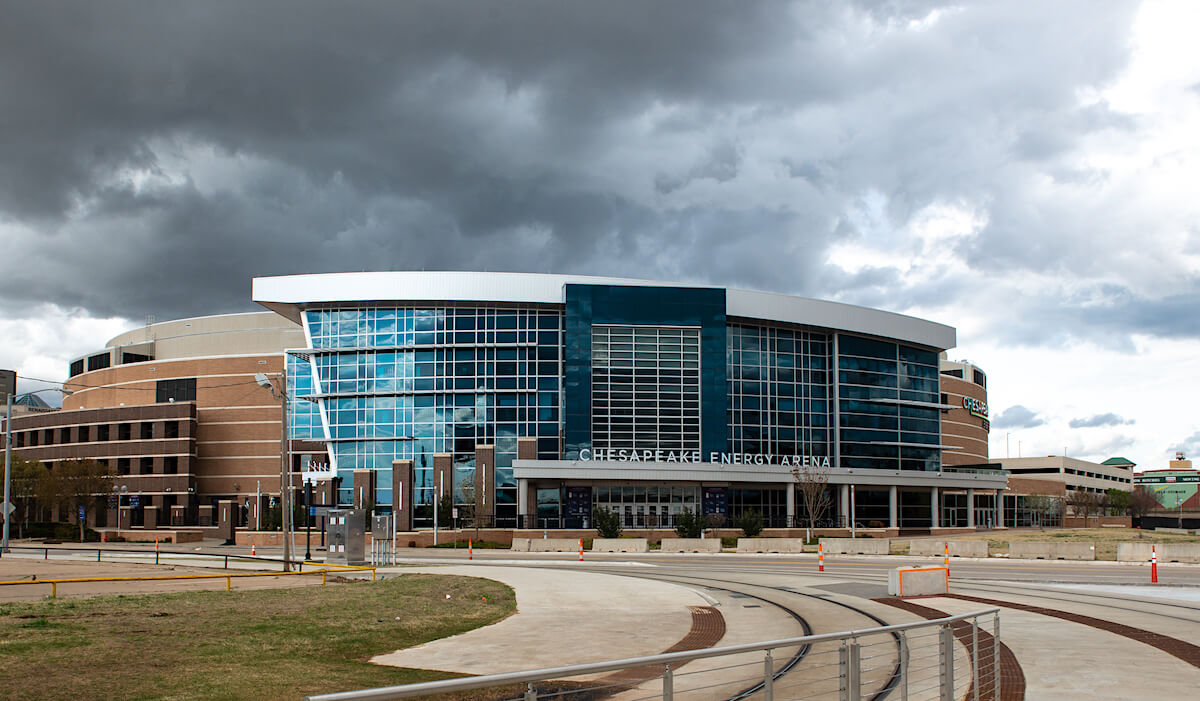
In Oklahoma City, the repercussions of Chesapeake’s heyday are most visible in the contributions the company made to the city’s businesses, nonprofits and culture. But the company has a much wider and more complex legacy in the oil and gas industry as a whole, as well as in the communities where it leased and drilled.
Just a few decades ago, conventional wisdom held that the energy industry had no future in the United States. Now, the U.S. is the world’s top oil producer — a transformation that has widespread implications for the economy, the environment and geopolitics.
Of course, Chesapeake was not single-handedly responsible for the fracking boom, but it might be credited with lighting the spark.
“More than any single company, Chesapeake completely transformed onshore U.S. oil and gas from a twilight industry to what it is today,” Berman said. “It was Chesapeake and Aubrey’s vision and leadership that got people onboard by saying, ‘This is the thing! We should do this!’”
The economic benefits of that industry turnaround were accompanied by detrimental effects, both tangible (such as pollution and earthquakes) and intangible.
The physical process of fracking is very different from traditional drilling. According to Sara Wylie, an assistant professor of sociology and health science at Northeastern University who studies the impacts of fracking, it takes a harder toll on the land, requires more infrastructure, creates more waste, and is on the whole significantly more disruptive to the surrounding environment and community.
In many regions Chesapeake pursued, it was one of the first companies to approach landowners looking for fracking rights.
“Lots of people, as they signed leases, didn’t really understand the difference between conventional and unconventional drilling,” Wylie said. “That it wasn’t the same as just conventional drilling that people had maybe historically been used to.”
Some landowners made a fortune from these leases. Others found themselves saddled with heavy costs.
Chesapeake, along with other companies, was known for employing aggressive landmen and for overselling what it was offering landowners, according to Ted Auch, an ecologist with the environment and health advocacy organization FracTracker.
“That doesn’t make them any different from most of the other players, but they were the first mover, and they were not what you would call honest brokers,” Auch said.
Dakota Raynes, a sociologist at Oklahoma State University who has studied the impact of the oil and gas industry on Oklahoma’s rural communities, discussed Chesapeake in a historical context.
“The relationship between oil and gas is different in Oklahoma because of things like Aubrey McClendon’s charitable work,” Raynes said. “You get this situation where oil and gas, which is the thing that pushed Oklahoma into statehood, has a really symbiotic relationship between the industry and other social institutions. Oil and gas became so enmeshed in the social fabric that people began to see everything they do as normal and acceptable even when there’s evidence to contrary.
“Once the industry dominates the economic, political and cultural landscapes, it shapes what people think things can look like. There’s less ability to imagine anything else.”
The uncertain future
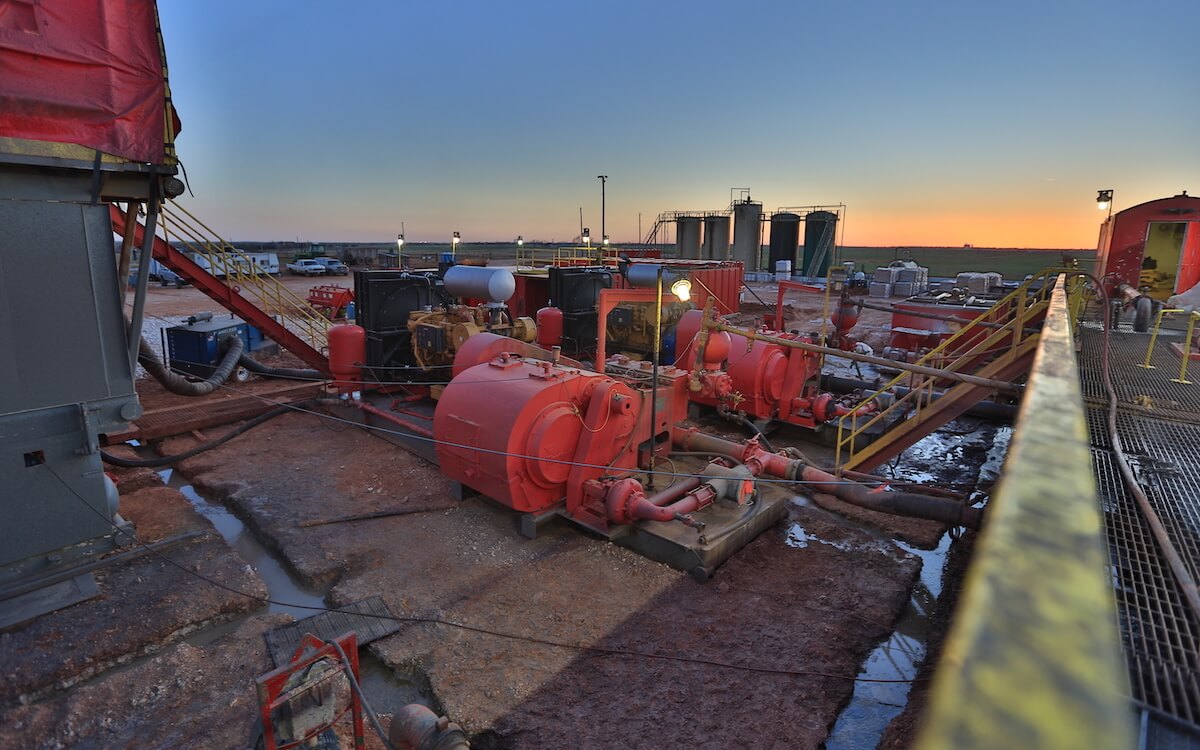
Chesapeake is far from the only oil-and-gas company struggling in the current economy. The industry saw an uptick of bankruptcies in 2019, and analysts predict many more will come. Some even argue Russia’s efforts to suppress oil prices are aimed at destroying U.S. shale companies like Chesapeake.
In Oklahoma, companies are preparing to ride out a slow-moving storm, even as OPEC reached a historic deal to cut oil production by 9.7 million barrels a day starting May 1.
“We are at least preparing for the possibility that this will be a long-term phenomenon we’re looking at,” said Jon Bargas, senior vice president of the Petroleum Alliance of Oklahoma. “There are some good signs. OPEC deciding to increase supply is not a silver bullet but a good sign over all for the industry. (…) But we certainly are doing what we can to prepare for this being a long-term situation.”
Whether Chesapeake can survive is a question burning in the minds of the company’s employees and civic leaders alike.
In imagining a potential future without Chesapeake, Williams, of the OKC Chamber of Commerce, said the hope from a citywide perspective would be that the company’s employees stay in the community and redirect their skills and talents.
“Any time a company goes under, you feel it,” he said, adding that Chesapeake’s demise would have “a gigantic impact” on the people who work there.
However, Williams also noted that previous downturns of the energy industry, and layoffs at Chesapeake specifically, have ended up feeding other sectors of the city. Many businesspeople became entrepreneurs, he said, and engineers went to work in the aeronautical industry.
“So as bad as it seemed, there was also something good that came out of it,” he said of past downturns. “When things fall off the tree, new things grow.”
Follow @NonDocMedia on:











